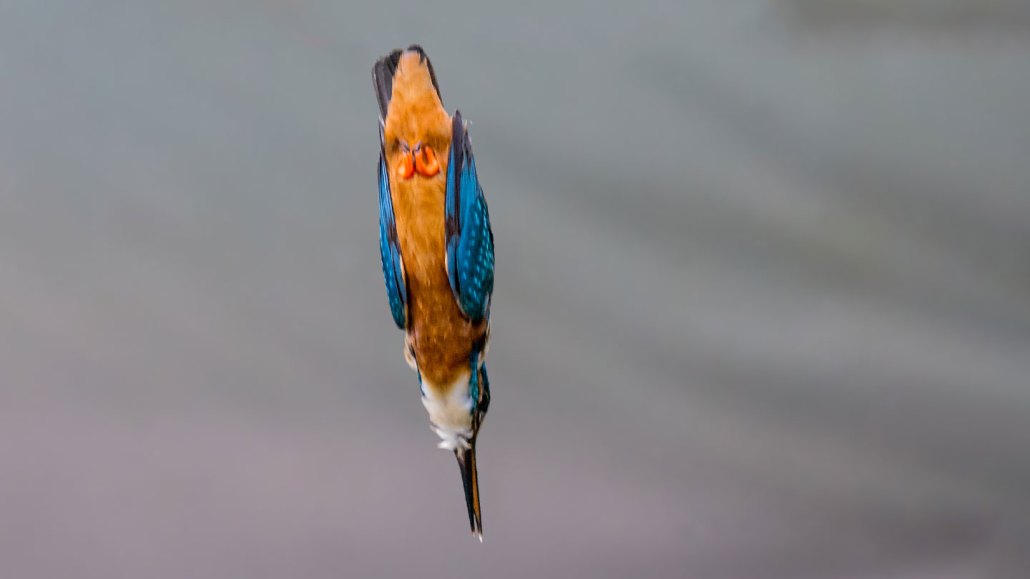Here’s how kingfishers avoid concussions during high-speed dives
Gene changes in their brains and eyes seem to protect the birds when plunging into water

Plunge-diving kingfishers (one shown) hit the water at speeds up to 40 kilometers (25 miles) per hour. These impacts risk damaging the birds’ beaks, heads and brains.
Andy Morffew/Flickr (CC BY 2.0 DEED)
Share this:
- Share via email (Opens in new window) Email
- Click to share on Facebook (Opens in new window) Facebook
- Click to share on X (Opens in new window) X
- Click to share on Pinterest (Opens in new window) Pinterest
- Click to share on Reddit (Opens in new window) Reddit
- Share to Google Classroom (Opens in new window) Google Classroom
- Click to print (Opens in new window) Print
Helmets aren’t an option for these birds. Luckily, kingfishers’ genes might protect them as they plunge beak first into the water.
As their name implies, some species of these birds catch fish. To do so, they dive at high speed into ponds or rivers. How fast? As much as 40 kilometers (25 miles) per hour. This puts huge amounts of pressure on their heads. As the birds dive again and again, they smack their heads in ways that would cause concussions in people, says Shannon Hackett. She’s a curator at the Field Museum in Chicago, Ill.
Diving species show differences in some genes active in their brains, eyes and blood vessels. These data suggest various species of diving kingfishers may have adapted some of the same ways to handle head-first hunting. These differences might point to how the birds cope with so many hits to their head.
Hackett’s team shared its new findings October 24 in Communications Biology.
An evolutionary biologist, Hackett first became interested in repeated hits to the head when she worked with her son’s hockey team. She worried about the effect of all those smacks to the human brain. That got her wondering how diving kingfishers protect their brains. Around the same time, evolutionary biologist Chad Eliason joined the museum. His job: to study kingfishers and their plunge-diving behavior.
Hackett, Eliason and researchers from a host of other organizations compared the DNA of 30 kingfisher species. Some of them plunge dive. Others don’t. The team took samples from birds that were frozen and stored at the museum. Those birds had come from all over the world.
Diving behavior evolved separately in different groups of kingfishers. The team wanted to know if species with the same behaviors had similar genetic changes. When different species independently evolve similar changes, it’s called convergence. For example, bats and dolphins independently developed echolocation. (That’s a way of using sound to sense an animal’s surroundings.) But it wasn’t clear whether plunge-diving evolved through convergence.
Previous studies had found convergence on beak shape. Plunging kingfishers’ beaks are long and pointy. This could allow them to dive more effectively into the water. Wondered Hackett, “Do they all [adapt to plunge-diving] in the same way with their beaks, their brain … and with their genes?”
A deep dive
The team found changes in 93 genes that seem to suggest genetic convergence in diving birds. One change stood out. It was in a gene for making a protein called tau. Tau helps cells keep their structure. A tweak to the tau gene could help the birds adapt to diving, the researchers now suggest.
Sometimes tau functions abnormally. It clumps in the brains of people who have had multiple concussions. Tau clumps also can signal brain disease, such as Alzheimer’s.
“It’s a very interesting hypothesis that the same [tau] protein has been reused” to help kingfishers cope with hard impacts, Tim Sackton says. He is a geneticist who did not take part in the new study. He works at Harvard University in Cambridge, Mass.
Sackton cautions that the study used a tricky type of analysis. Some of those 93 gene changes might be due to chance. That is, they may not relate to the evolution of plunge-diving behavior. People will need to study those changes more closely to figure out which in fact relate to that behavior, he says.
The next step is to test what these genetic changes do in kingfishers. One big question is the effect of the protein made by the changed tau gene. Another is how genetic differences might protect diving species.
“We have a long way to go” to understand how genes “turn into what we see in the natural world,” Hackett says. But the answer here might one day be applied to protecting human brains from concussions and brain injury.
But that’s in the distant future, Hackett says. “We’re just at the beginning of asking those questions.”







